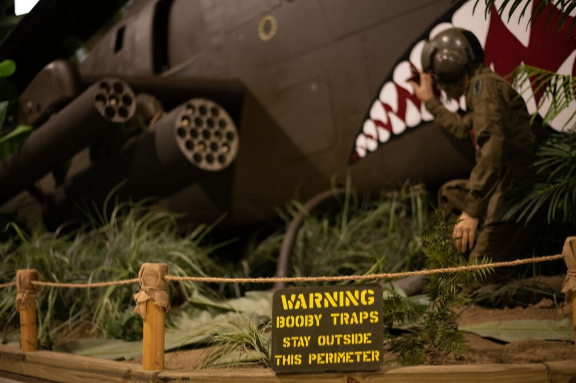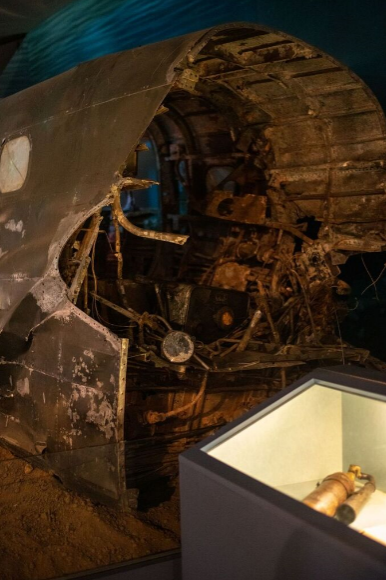
By Erica Wright
The Birmingham Times
During her recent and first visit to the Southern Museum of Flight (SMOF) in Birmingham, Julie Ferguson of Moody learned more about the history of flight in the city and state than she ever imagined.
“Some of the airplanes in here were actually built at someone’s house,” said Ferguson, who was on a field trip to the museum with her 5-year-old son. “There’s also part of the exhibit that shows the original land the [museum] was built on, [which] used to be a landfill. It’s been interesting to see the origin of not only the museum but these airplanes, as well.”
Ferguson is one of about 60,000 annual visitors to the SMOF, which is just a few miles away from the Birmingham-Shuttlesworth International Airport in East Birmingham.
The 75,000-square-foot facility—one of the largest aviation museums in the Southeast—is dedicated to presenting civilian, military, and experimental aircraft and memorabilia from the earliest history of powered flight; it houses more than 100 aircraft, as well as engines, models, artifacts, photographs, and paintings.
The museum is also home to the Alabama Aviation Hall of Fame, which features more than 70 biographical plaques showcasing the state’s aviation history.
“We trace our roots back to 1966,” said SMOF Executive Director Brian Barsanti, PhD. “We started out as a display case in the library at Samford University, and we grew from there in the 1960s to this location in 1983. In the mid-’90s, we expanded and doubled the size of this facility.”
Groundbreaking ceremonies were held in 1978 at the museum’s current location at 4343 73rd St. N; the museum officially opened in the fall of 1983.
“Extension of the Classroom”
The SMOF investigates, preserves, and promotes the rich stories of Southern aviation and offers experiential educational programming for people of all ages.
“Over the last decade, the museum has really taken on an education-oriented mission,” said Barsanti. “We view ourselves as an extension of the classroom. All of our tours and programs correlate with the Alabama Course of Study Standards, so when schools take field trips out here, they can weave it right into their curriculum. We fill in any gaps the teachers leave open and become an extension of what they’re doing.”
Ferguson, who was at the SMOF with her son, agreed.
“You really learn the history of where everything came from, … where the stories came from, the history of America and Alabama, … the history of Birmingham,” she said. “I think this museum plays a huge role in the history of our state and our city, and everyone should come and see that. … It interests kids, too, and could possibly [inspire them to] one day want to become a pilot or an aircraft engineer.”
The museum’s curriculum includes not only history and social studies but also a focus on science, technology, engineering, and math (STEM), said Barsanti, who served in the U.S. Army and U.S. Coast Guard, “We offer a computer lab and flight simulation [technology].
“Right now, we’re on the eve of offering a virtual reality component to the tour so [visitors] can sit in a fighter aircraft or bomber, put the headset on, and fly the real deal to get that experience,” he said. “There are math and science lessons, principles of flight, Newton’s law. … All those things are part of a broad academic curriculum, and those things are important to us.”
Restoration through Education
Aircrafts come to the SMOF in a number of ways.
“We acquire many of them: some come from branches of the military; some, like the general aviation planes, come from private donors,” said Barsanti. “Because many of them are acquired, they may be damaged or have various issues, so we restore those aircraft that are in need.”
There is an on-site shop, where technicians refurbish the aircrafts with paint and metal work; they also fix engines. A rehabilitation project can take a few weeks or a few years, depending on the severity of the damage or the size of the aircraft. For example, an aircraft that might need only repainting or polishing could take a week or two; an aircraft that has been damaged or hasn’t been maintained could take years. SMOF technicians are currently working on a B-25 once flown by the Tuskegee Airmen—a restoration project that has been in the works since 2015.
“Many of these, especially these war birds from back in the day, are obsolete, so you can’t go to the local aircraft parts store and get the parts for it. It can be a difficult process,” said Barsanti. “If we can’t find the parts we need, sometimes we have to manufacture or recreate them here, so [a restoration can be] dependent upon all of those things.”
Exhibits
A SMOF tour begins with an exhibit of early history of flight, highlighting pioneers like the brothers Orville and Wilbur Wright, two American aviation pioneers generally credited with inventing, building, and flying the world’s first successful motor-operated airplane; Amelia Earhart, the first female aviator to fly solo across the Atlantic Ocean; and Bessie Coleman, the first African American woman to receive a pilot’s license.
The next exhibits feature commercial and general aviation, as well as military aircraft. There’s also an exhibit dedicated to the legendary Tuskegee Airmen—the first black military aviators in the U.S. Army Air Corps, who fought valiantly in World War II. The museum also has an outdoor exhibit.
Along the way, visitors learn about the aviation industry and its ties to Alabama and Birmingham. For example, Alabama’s first aeronautical event took place in March 1910, with the flight of a Wright biplane flown by Orville Wright in Montgomery, Ala., where he opened the nation’s first civilian flight training school. (The location would ultimately become Maxwell Air Force Base.)
Barsanti said. “[The museum] is primarily broken down by era, so when you take a tour you go on a virtual timeline that starts with the early Wright brothers through the early 20th century, [moves on to] the Tuskegee Airmen and that World War II period, and then [showcases] the more modern-day pieces. A few pockets are organized by category, like the type of aircraft, but for the most part [the museum is set up] chronologically.”
The SMOF also has month-specific exhibits, such as one on women aviation pioneers for the Women’s History Month and the ongoing restoration of the B-25 flown by the Tuskegee Airmen for Black History Month.
“Visitors can engage and talk with our restoration technicians about what they’re doing to restore the aircraft,” said Barsanti. “It’s a simple way to make [the experience] interactive without any technology or touch screens. Visitors simply engage with the guys working on the aircraft, who explain what they’re doing and the story behind it.”
Because of the extensive collection, pieces in exhibits are often changed out every few months.
Workforce Development
The SMOF plans to spread its wings, so to speak, to include workforce development programs.
“We anticipate [collaborating] with the Alabama community college system, to offer coursework in aviation-oriented fields, such as maintenance, avionics, or aviation electronics,” said Barsanti, who started at the museum selling admission tickets and cleaning bathrooms before becoming executive director. “We want to [work with] traditional college students, students who are looking for something but maybe haven’t found it yet. We’re looking for dual-enrollment students, military members looking to transition from maybe the Air Force or Air Guard to civilian life. … There is a pathway for them to do that.”
The museum is looking for a “trickle up” effect that will offer students pathways to receive two- or four-year degrees, Barsanti said. Students will be able to begin by taking short-term certification classes and eventually earn associate degrees before attending institutions like the University of Alabama at Birmingham (UAB), the University of Alabama (UA), or Auburn University (AU), giving them seamless transition into bachelor’s degree programs, he said.
The Southern Museum of Flight is open Tuesday through Saturday from 9:30 a.m. to 4:30 p.m. Admission is $7 for adults; $6 for seniors and students; and free for children 3 years old and younger, as well as active military members and their families. For more information, visit Southern Museum of Flight on Facebook and Instagram and @SMOF1 on Twitter, or call 205-833-8226.
























